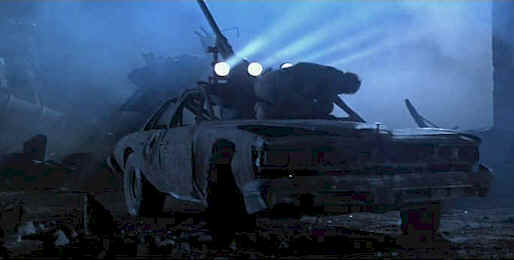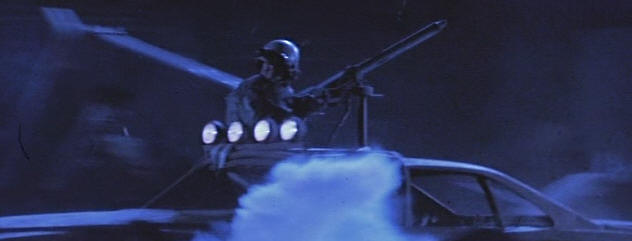

GENERAL DYNAMICS RSB-80 HEAVY PLASMA GUN



"Reese glanced
up as he heard the security door being unlocked and opened. Another
patrol was coming through, visible in the distance under the dim portable
fluorescents. Two scouts. The dogs were smelling
their hands. Then another man pushed through before the sentries could
close the door. He was a head taller than the others, and carried
something bulky under his torn gray poncho.
The dogs began
barking furiously at the last man. The sentries were already going for
their weapons. One was yelling, "Terminator! Terminator!"
Reese hung frozen for
a half second as the terminator threw back its poncho and lifted the General
Dynamics' RSB-80 to fire. The weapon cracked, and the bunker was seared
with light."
-Frakes and Wisher, "The
Terminator"
|
|
|
|
MANUFACTURER: |
General
Dynamics Advanced Automated Manufactory, Also available in template form at any Series III or higher construction facility
|
|
PRODUCTION: |
09:08:2012
to 07:04:2029 A.D. |
|
TYPE: |
High gain,
high capacity feed semi-portable plasma gun |
|
CONSTRUCTION: |
Enduralloy components mated to carbon fiber and moly
fiber carrier, misc. plastics and metals with superconducting filaments. |
|
OPERATION: |
Level VII
magnetic field containment of refined hydrogen fuel excited with thermal
rapid pulse chemical high energy laser ignition system. |
|
BORE
SIZE: |
20mm / 15mm
magnetically stabilized and insulated smoothbore |
|
WEIGHT: |
35.5kg,
unloaded. |
|
DIMENSIONS: |
Length
overall, 1.75 meters (1750mm) |
|
AMMUNITION: |
M90T1
Integrated Fuel Power (IFP) type stacked array cassette containing enough
refined hydrogen core fuel and battery power to initiate and produce 300
sustained plasma pulses. Later capacity increased to 500 shots with introduction
of M42T2 series high capacity power cassette. |
|
FEED
SOURCE: |
300 pulse
capable refined hydrogen fuel cell combined with coaxial high density Type
VII crystal storage array. Later models are fed by 500 pulse capable
fuel cell cassette equipped with Mod 4 Type VII high density crystal power
storage matrix. Linear input feed port for use in mounted applications
can draw fuel and power from onboard asset resources for unlimited duration
firing. |
|
RATE OF
FIRE:
|
60 pulses
per minute sustained given cooling cycle and single rate of fire. Unit
capable of select fire in three round bursts or full automatic fire.
Cyclic rate of fire on full auto is 360 pulses per minute. Onboard
diagnostic and safety interface systems prevent weapon overheating by locking
out firing system if core temp rises beyond acceptable levels. |
|
PROJECTILE: |
0.75 Mj phased plasma bolt, flow wash temp at +4500 degrees |
|
MUZZLE
VELOCITY:
|
Staged
hand-off coils accelerate bolt to a velocity of 9000 meters per second
(9.0kps). |
|
|
2500 meters
(bolt integrity destabilizes and cohesion factor approaches .85%
dispersal). Bolt reaches maximum range in 0.27 seconds. |
|
|
1500 meters
(at this point bolt begins to lose cohesion, dispersal factor starts to
rise). Bolt reaches effective range in 0.16 seconds. |
|
PERFORMANCE: |
Contact hit produces 15mm diameter entry point forming
destructive tunneling of target material through kinetic energy and super
thermal contact. Upon negative penetration or contact with a superior
surface, bolt will destabilize into high speed thermal tributary fragments
with a one meter lethal splash radius. Laser excited, magnetically
accelerated 15mm x
1000mm pre-emptive phased conversion thermal bolt will penetrate 15cm of case
hardened steel up to effective range with loss of overall penetration
commensurate with range after that. Immediate transfer of thermo-kinetic
energy to soft target tissues and standing fluids rated at greater than 95%
with high speed liquid to vapor thermal expansion. High duration of
residual thermal effects noted in hard surfaces struck by plasma fire.
Explosive displacement of up to one cubic meter of material may result from
bolt impact with material having trapped water or water vapor inside (porous
rock, concrete, masonry, etc.) with lethal spall
out to one point five meters from point of impact due to explosive decoupling of material
cohesive structure. |
|
DAMAGE
INDEX:
|
Consistent
Damage Index of 240 / 15 representing at effective range the 15mm x
1000mm bolt will penetrate 240 cm of standard ballistic gelatin with a wound
channel radiating out 15 cm from the point of impact narrowing from that
radius in accordance with depth and tensile strength of target material as
the bolt loses temperature and velocity. This index rating does not
take into account any standing liquids such as water or blood that may be
encountered as such liquids will be instantaneously vaporized thus greatly
increasing the wound channel radius through flash heating causing high
velocity steam expansion and lethal bursting of soft tissues over a large
volume of body area. |
HISTORY:
The RSB-80 was a support
grade rapid pulse phased plasma gun intended for use with light as well as
medium combat chassis equipped models, namely the Mark IV through Mark VI
series. Larger and heavier than the M95 series weapons, the RSB-80, produced
at the General Dynamics Advanced Assembly Center (GDAAC) in Austin, TX, became
the main weapon of most of SKYNET's light and medium
combat models from 2015 to 2021 A.D. The Westinghouse automated facility did not
have the capacity to produce a high gain, high capacity plasma weapon like the
RSB-80 but the General Dynamics automated installation, where most of SKYNET's
heavy energy weapons were designed and manufactured, did.
The RSB-80 was long and heavy, nearly two meters in length and weighing in at over 40
kilograms fully fueled. The RSB-80 excelled as a light rapid fire tactical support weapon and was
used in a variety of different models and chassis combinations produced by
SKYNET. The rapid cycling Type 3 Level VII containment bottle gave the
plasma bolts a greater integrity hand-off field envelope, producing a much
stronger bolt over a longer distance. In single shot mode, the RSB-80,
when mounted to a stable chassis, could make precision shots out to maximum
effective range. The explosive decoupling of material struck by the high
power bolt meant that there was less effective means of cover for human targets
and that even a near miss might result in lethal plasma or fragment based spall.
The RSB-80 proved popular with the humans as well though its weight and mass was troublesome. Too heavy for an average human to pick up and wield, the RSB-80, like most of SKYNET's other large frame high gain plasma guns, was easily adaptable to a variety of standard NATO support tripods and ad hoc custom built mounts, some powered, others not. It was inevitable that the technology of the RSB-80 would fall into human hands and tentative deep penetration raids by Endoskeleton units often found captured RSB-80 guns mounted to where they could be used to defend avenues of approach to the human warrens and reserves. The RSB-80 proved to be an effective anti-material weapon as well, as was documented by many instances of penetrating Endoskeleton units falling to rapid damage matrixes incurred from repeated hits at close range by the high gain plasma guns.


An example of a
captured RSB-80 in human service, mounted on an old GM car (produced circa mid
1970's)
which is itself serving as a mobile rapid deployment platform for the
weapon.
The Resistance operated many of these "technicals" though never in large numbers in either fleet or scenario situations.
The newer T600 series
Terminators and later series of heavy combat bipeds were not only equipped with
the enhanced hydraulics and reinforced frame / chassis to carry and brace the
RSB-80 series weapons, but they were also programmed to take
advantage of the RSB-80's unique operational characteristics. The RSB-80 formed the core
weapon selection of the heavy tracked HKs in the
beginning, being the mainstay of the movement from the cumbersome and
mechanically complex chain-fed heavy weapons to the more simple yet effective
liquid fueled plasma weapons. Only later in 2019 A.D. was the RSB-80
series weapon replaced in main attrition unit production by the higher capacity
RSB-125 series of high gain plasma guns. The use of the newer high gain plasma guns
didn't remove the RSB-80 from active use, it was merely relegated to a secondary
echelon of deployment, being used in many
different roles from autonomous gun emplacements and pillbox type bunkers guarding key
areas to being carried by individual Terminators and Infiltrators on deep penetration missions
and underground bunker raids. The power of the RSB-80 was incredible
within its effective range and still had good anti-personnel capacity out to
almost its maximum range. This performance envelope
allowed SKYNET's units to quickly eliminate any
threat subjects in the effective range despite those targets being in
relatively hard cover.
History shows
that about one in twenty-five Endoskeleton units operating in coordinated effort
on the battlefield was equipped with a RSB-80 weapon, and it seems
likely that this was done more out of a squad support type role in the overall
order of battle. The RSB-80 was
also used in a variety of static defense positions at SKYNET controlled
installations, mainly in powered remote gun emplacements with independent
sensor and scanner as well as target tracking and acquisition / engagement
systems. Power was usually supplied
through dedicated ground lines along with fueling
conduits for the plasma intake manifolds.
Backup power and fuel systems were also included in the design of the
automated turrets.

_______________________________